This ETF assessment was prepared in 2019. The assessment process included desk research based on responses to a standardised questionnaire (the national reporting framework), compiled by an ETF expert, which resulted in the Bosnia and Herzegovina Torino Process report (referenced in this assessment as the Bosnia and Herzegovina report)[3] At the time of writing the ETF assessment, the Bosnia and Herzegovina report had not been endorsed by local stakeholders.
. Other additional reports have been used where relevant. Key findings were presented and discussed at a consultation meeting in Sarajevo (April 2019) with key country stakeholders and representatives of the EU Delegation.
This ETF assessment comes at an important point as Bosnia and Herzegovina prepares for the next multiannual cycle of reform implementation, which includes preparation for EU support through the next generation of the Instrument for Pre-accession Assistance (IPA) in the period 2021–2027. The report is expected to help prioritise reforms and devise actions by providing input to policy makers in the area of education and training. The assessment findings complement the monitoring of the Economic Reform Programme from a sector point of view.
Like other ETF assessments, this paper is not meant to be exhaustive. It focuses on challenges, which the ETF recommends addressing as a matter of priority.

